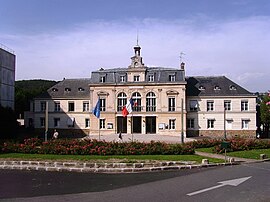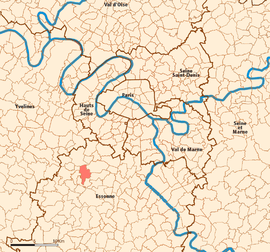Orsay: Difference between revisions
Tags: Mobile edit Mobile web edit |
Expanded lead with content from the existing French Wikipedia article at fr:Orsay; see its history for attribution. |
||
| Line 30: | Line 30: | ||
'''Orsay''' ({{IPA-fr|ɔʁ.sɛ|pron}}) is a [[Communes of France|commune]] in the [[Essonne]] [[Departments of France|department]] in [[Île-de-France (region)|Île-de-France]] in northern [[France]]. It is located in the southwestern suburbs of [[Paris]], [[France]], {{convert|20.7|km|mi|abbr=on}} from the [[Kilometre Zero|centre of Paris]]. |
'''Orsay''' ({{IPA-fr|ɔʁ.sɛ|pron}}) is a [[Communes of France|commune]] in the [[Essonne]] [[Departments of France|department]] in [[Île-de-France (region)|Île-de-France]] in northern [[France]]. It is located in the southwestern suburbs of [[Paris]], [[France]], {{convert|20.7|km|mi|abbr=on}} from the [[Kilometre Zero|centre of Paris]]. |
||
A fortified location of the [[Vallée de Chevreuse|Chevreuse valley]] since the 8th century and agricultural domain of wealthy and influential people, the development of Orsay is marked by the introduction of a [[Rail transport|railroad]] in the second half of the 18th century (today the [[RER B]] of which two stations are located in Orsay) and donations which allow the construction of a hospital still active to this day. Seat of the Orsay campus of [[Paris-Saclay University|Paris-Saclay university]], crossed by the 118 national road, Orsay has become a residential city of the [[Paris metropolitan area]] and the [[Vallée de Chevreuse|Chevreuse valley]], easily accessible and with a preserved [[Natural environment|environment]] at the heart of the [[Paris-Saclay]] scientific cluster with laboratories of the [[French National Center for Scientific Research|CNRS]] and the [[Curie Institute (Paris)|Curie institute]] on its territory. |
|||
Inhabitants of Orsay are known as ''Orcéens''. |
Inhabitants of Orsay are known as ''Orcéens''. |
||
Revision as of 13:07, 22 October 2020
You can help expand this article with text translated from the corresponding article in French. (July 2014) Click [show] for important translation instructions.
|
Orsay | |
|---|---|
 Town hall | |
 Location (in red) within Paris inner and outer suburbs | |
| Coordinates: 48°41′57″N 2°11′15″E / 48.6993°N 2.1875°E | |
| Country | France |
| Region | Île-de-France |
| Department | Essonne |
| Arrondissement | Palaiseau |
| Canton | Palaiseau |
| Intercommunality | CA Paris-Saclay |
| Government | |
| • Mayor (2014–2020) | David Ros |
Area 1 | 7.97 km2 (3.08 sq mi) |
| Population (2021)[1] | 16,007 |
| • Density | 2,000/km2 (5,200/sq mi) |
| Time zone | UTC+01:00 (CET) |
| • Summer (DST) | UTC+02:00 (CEST) |
| INSEE/Postal code | 91471 /91400 |
| Elevation | 51–160 m (167–525 ft) (avg. 90 m or 300 ft) |
| 1 French Land Register data, which excludes lakes, ponds, glaciers > 1 km2 (0.386 sq mi or 247 acres) and river estuaries. | |
Orsay (pronounced [ɔʁ.sɛ]) is a commune in the Essonne department in Île-de-France in northern France. It is located in the southwestern suburbs of Paris, France, 20.7 km (12.9 mi) from the centre of Paris.
A fortified location of the Chevreuse valley since the 8th century and agricultural domain of wealthy and influential people, the development of Orsay is marked by the introduction of a railroad in the second half of the 18th century (today the RER B of which two stations are located in Orsay) and donations which allow the construction of a hospital still active to this day. Seat of the Orsay campus of Paris-Saclay university, crossed by the 118 national road, Orsay has become a residential city of the Paris metropolitan area and the Chevreuse valley, easily accessible and with a preserved environment at the heart of the Paris-Saclay scientific cluster with laboratories of the CNRS and the Curie institute on its territory.
Inhabitants of Orsay are known as Orcéens.
History
There has been a village called Orsay on this site since 999, and the first church there was built in 1157. From the sixteenth century, the town and surrounding area were owned by the Boucher family, and it was in honour of this family that Louis XIV gave the quai d'Orsay its name. This is the reason that the Musée d'Orsay is not in Orsay. In the eighteenth century, the family of Grimod du Fort bought the land and received the title of comte d'Orsay. In 1870, during the Franco-Prussian war, Orsay was occupied by the Prussian army. 88 young "Orcéens" were killed in the First World War.
In 1957, largely due to the influence of Frédéric and Irène Joliot-Curie, the Institut de physique nucléaire (nuclear physics institute) was opened in the Chevreuse valley, and the region, especially Orsay, became an important scientific centre. Another development was the creation of the Université de Paris-Sud, whose most important faculty is the faculty of science.
On 19 February 1977, a part of the territory of Orsay was detached and merged with a part of the territory of Bures-sur-Yvette to create the commune of Les Ulis.
Transport
Orsay is served by two stations on Paris RER line B: Le Guichet and Orsay-Ville.
Neighbourhoods of Orsay
- Le Guichet
- Mondétour
- Le Petit Madagascar
- Corbeville
Nearby towns
Places of worship
Orsay has one Catholic church: Saint-Martin – Saint-Laurent, opposite the town hall. It also has an International Evangelical Church called Église Évangélique Vie et Paix at 14 Rue Charles de Gaulle.
Civil heritage
Forested areas
- The Bois des Rames around the university campus
- The Bois Persan
- Parc botanique de Launay
Architecture
- la Grande Bouvêche
- la Pacaterie
- le Temple de la Gloire
- le château de Corbeville
Notable residents
- Sir Oswald Mosley, Bt., leader of the British Union of Fascists
- Lady Diana Mosley, one of the Mitford sisters and wife of Sir Oswald Mosley
- Edward VIII of the United Kingdom, later Duke of Windsor after abdicating the throne and marrying American divorcee Wallis Simpson
- Wallis, Duchess of Windsor, American wife of Edward VIII of the United Kingdom
- Moussa Badiane, basketball player
- Sega Keita, footballer
- Guy Demel, footballer
- Mickael Antoine-Curier, footballer
- Angelique Spincer, handball player
- Teddy Venel, athlete
- Dina Dabjan-Bailly
- Kal Dupchen (Artist) USA
- Adam Allouche, swimmer
References
- Mayors of Essonne Association (in French)
- ^ "Populations légales 2021" (in French). The National Institute of Statistics and Economic Studies. 28 December 2023.
External links
- Orsay official website (in French)
- Mérimée database - Cultural heritage (in French)
- Land use (IAURIF)[permanent dead link] (in English)




